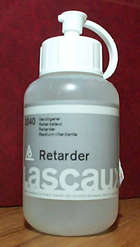|
|
©1999-2003. All rights reserved. |
My Experience of
Acrylic Retarder
What is it?
| |||
|
Acrylic is made up of pigment, which provides the colour, and a colourless medium which binds the particles of pigment to the object being painted. The medium used in acrylic dries very quickly, even when mixed with water. This means that you will rarely be hanging around waiting for it to dry, but is a problem when trying to blend, as this process relies on the paint not being fully dry. Retarder is a clear substance which prevents the acrylic from drying so quickly. It can be bought from most good art shops. This one came from the Canonbury Art Shop, Upper Street, Islington and cost £4.40. I have heard that glycerin will have the same effect, but I didn't have any and couldn't be bothered to experiment.
|
|
Usage

The most appropriate use for retarder is blending because you need to mix two or more colours before the first has gone rock solid.
Transluscency Problem
Unfortunately retarder not only increases drying time but also affects
the opacity of the paint. It takes
quite a high proportion of retarder to paint to significantly increase
drying time. I found at least a 1:2 or 1:3 ratio of retarder to paint
was needed. With less retarder the paint still lasted much longer on
the palette, but once it had been applied in a thin layer to the figure,
it dried almost immediately. Once the amount of retarder has been increased
enough to up the 'on-figure' drying time, it will also have started
to become transluscent.
This isn't too much of a problem when shadowing a base coat, but with highlighting there is more of a problem. The pale colour will not cover properly and the colours will tend to look rather grey and washed out. The effect is difficult to describe, but you will know it when you see it. To make the transluscency less of a problem it is often best to make the base coat at the lighter end of the spectrum being shaded. You could also try taking some of the highlighting shade without any retarder in it and apply blobs of it to the raised areas before starting the blending process. This way all the paint with retarder in it will be darker than the underlying colour.
Mixing in the retarder
Getting the retarder into the paint is also not as easy as you might
think.Mixing retarder into a single colour of paint is fine, but blending
needs to simultaneously use a range of shades usually containing three
or four original paint colours in varying proportions. Getting an even
quantity of retarder into this lot without stirring it all into a monochrome
mass is tricky. I tried applying it to the figure first, but this wasn't
very successful because the areas that weren't subsequently mixed with
paint took weeks to dry.
Mixing with one colour only
To get round these problems, my favourite technique is to mix the retarder
primarily with the darkest end of the blending range. This way the transluscency
will not be too much of a problem because slightly transluscent dark
colours will go on fine over light but not vice-versa. In fact they
can actually look slightly more vibrant because the light colours 'shine'
through. The dark colour should go onto the figure first, and the retarder
will stop this drying while you blend in the unadulterated lighter colours.
Verdict

I haven't found the end results are noticeably better, but retarder can definitely speed up the process of blending by assisting in the continual battle to avoid an area drying out before it is finished. It also does make it slightly easier to get a smooth blend once you have become acclimatised to the transluscency problem. Retarder does seem to present as many problems as it solves, and it would be all too easy for the novice painter to end up with a muddy mess. Give it a go, but don't expect an easy shortcut to beautiful blending.


